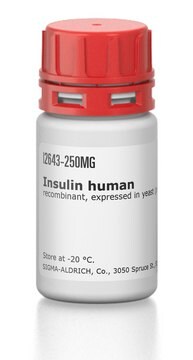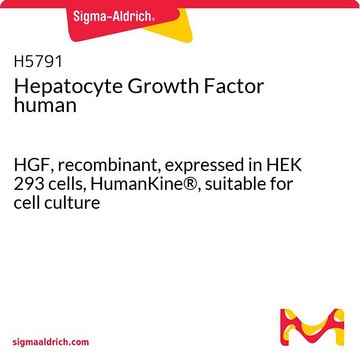G3046
GDF-15 human
Synonym(s):
Growth differentiation factor 15, MIC-1, Macrophage inhibitory cyotkine-1
Sign Into View Organizational & Contract Pricing
All Photos(1)
About This Item
Recommended Products
biological source
human
Quality Level
recombinant
expressed in CHO cells
Assay
>97% (visualized with silver stain, SDS-PAGE)
form
lyophilized powder
mol wt
dimer 13 kDa (based on N-terminal sequencing, starting at the first histidine of the 6X histidine tag)
technique(s)
cell culture | mammalian: suitable
impurities
endotoxin, tested
UniProt accession no.
storage temp.
−20°C
Gene Information
human ... GDF15(9518)
General description
Growth-differentiation factor-15 (GDF-15) is a stress-responsive member of the transforming growth factor-β cytokine superfamily. It is also known as PTGF-Growth-differentiation factor-15 (GDF-15) and is a stress-responsive member of the transforming growth factor-β cytokine superfamily.2 It is also known as PTGF-β, TGF-PL or MIC-1β, TGF-PL or MIC-1.
Application
Growth-differentiation factor-15 (GDF-15) has been associated in the regulation of cell survival, proliferation, and differentiation and also in the protection from ischemia/reperfusion injury. Inflammatory and apoptotic pathways are regulated in injured tissues by GDFs during disease processes.
Biochem/physiol Actions
Although it has been classified as a divergent member of the transforming growth factor-β superfamily, GDF-15 shares structural characteristics with this superfamily. It has been identified as a biomarker for human prostate cancer. Additionally, increased GDF-15 expression has been observed in breast, pancreas and colorectal cancers. Functions of this cytokine include inhibition of TNF-α production, initiation of cartilage formation, and promotion of neuronal survival.
It has been discussed to serve as a secreted biomarker for activation of the p53 pathway in human cancer.
It has been discussed to serve as a secreted biomarker for activation of the p53 pathway in human cancer.
Physical form
Lyophilized from a 0.2 μm filtered solution in 30% acetonitrile, 0.1% trifluoroacetic acid containing 50 μg of bovine serum albumin per 1 μg of GDF-15.
Analysis Note
Under reducing conditions in SDS-PAGE, each recombinant GDF-15 monomer migrates as an ~14 kDa protein.
Storage Class Code
11 - Combustible Solids
WGK
WGK 3
Flash Point(F)
Not applicable
Flash Point(C)
Not applicable
Choose from one of the most recent versions:
Already Own This Product?
Find documentation for the products that you have recently purchased in the Document Library.
K P Bland et al.
Quarterly journal of experimental physiology (Cambridge, England), 74(6), 813-824 (1989-11-01)
In order to examine whether an aspiration mechanism exists in the vomeronasal organ (VNO) of the domestic ram, experiments were conducted in chloralose-anaesthetized animals using acute electromanometry and electrophysiological techniques. Stimulation of the ipsilateral cervical sympathetic nerve activated a mechanism
Renal failure and the histopathological features of myeloma kidney reversed by intensive chemotherapy and peritoneal dialysis.
P E Rose et al.
British medical journal (Clinical research ed.), 294(6569), 411-412 (1987-02-14)
Jennifer Lee et al.
PloS one, 10(6), e0131506-e0131506 (2015-06-27)
Although inactivating frameshift mutations in the Transforming growth factor beta receptor type 2 (TGFBR2) gene are considered as drivers of microsatellite unstable (MSI) colorectal tumorigenesis, consequential alterations of the downstream target proteome are not resolved completely. Applying a click-it chemistry
Our team of scientists has experience in all areas of research including Life Science, Material Science, Chemical Synthesis, Chromatography, Analytical and many others.
Contact Technical Service








